Arctic Adventure in Tromsø
Tromsø, Norway
Tromsø is a breathtaking city in Northern Norway, located about 200 miles north of the Arctic Circle. Our entire stay in Tromsø felt like we were living in a snow globe. The city and surrounding nature is truly a winter wonderland that felt warm and vibrant even during the darkest and coldest time of the year. During our stay, we saw the Northern Lights, snowshoed up a mountain overlooking a fjord, fed reindeer and learned about the indigenous Sami culture.
Gateway to the Arctic
Tromsø is considered to be the gateway to the Arctic. Its proximity to the Norwegian Sea and temperate climate for its position so far north have made it an ideal spot for Arctic explorers and expeditions throughout history. Its location under the Aurora Oval makes it a prime place to view the Northern Lights.
Polar Night & The Midnight Sun
For two months, from late November through late January, the sun does not rise above the horizon. During this time of the the year, known as Polar Night, nearly all hours of the day are dark. For a few short hours during the morning, the sky brightens up enough to feel like an extended dawn. The addition of snow makes the landscape feel even brighter as it reflects more natural light.
The opposite is true from late May through late July. During this time of the year, known as the Midnight Sun, the sun never sets below the horizon. It stays bright for all hours of the day however when the sun reaches closest to the horizon, the sky lights up with beautiful colors seen during sunset and sunrise.
The Northern Lights
One of the most popular things to do in Tromsø is watch for the Northern Lights. The city sits directly under the Aurora Oval, the ovular path the Northern Lights appear above Earth’s northern magnetic pole. As a result, if the conditions are right, the Aurora can be seen dancing and swaying above Tromsø during the evening. The best time of the year to see the Aurora in Tromsø is from late September through early April. We visited from late November through early December.
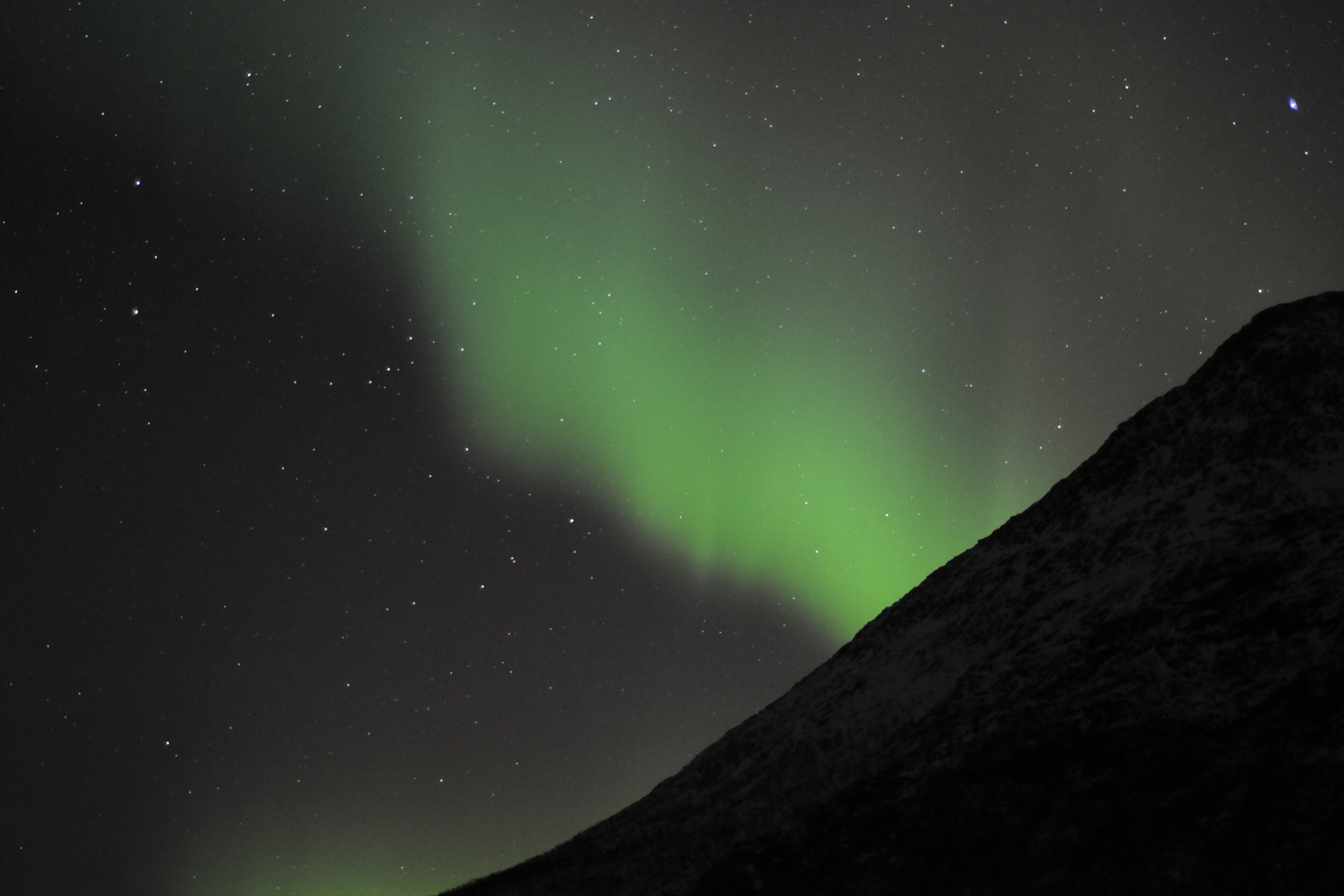
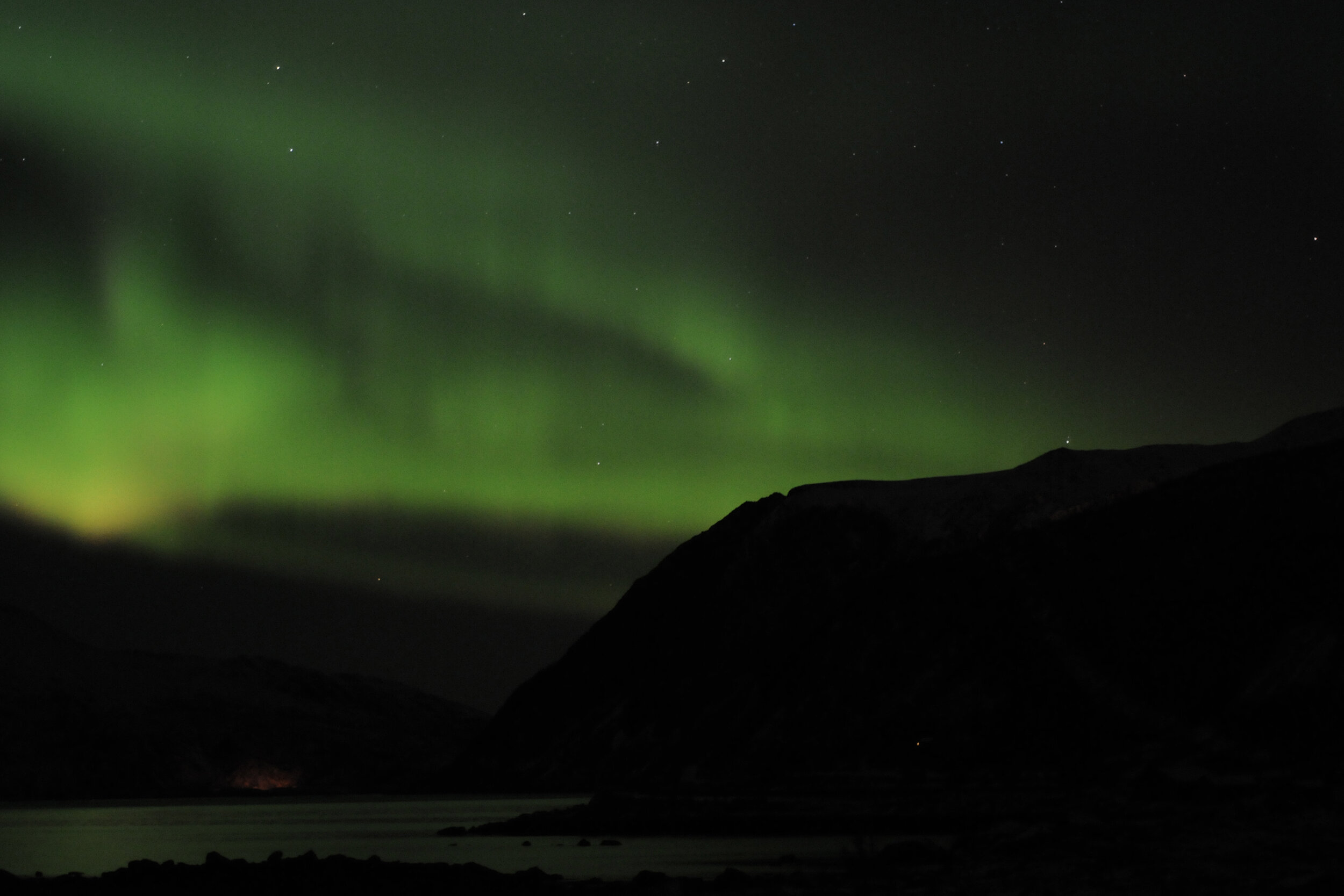
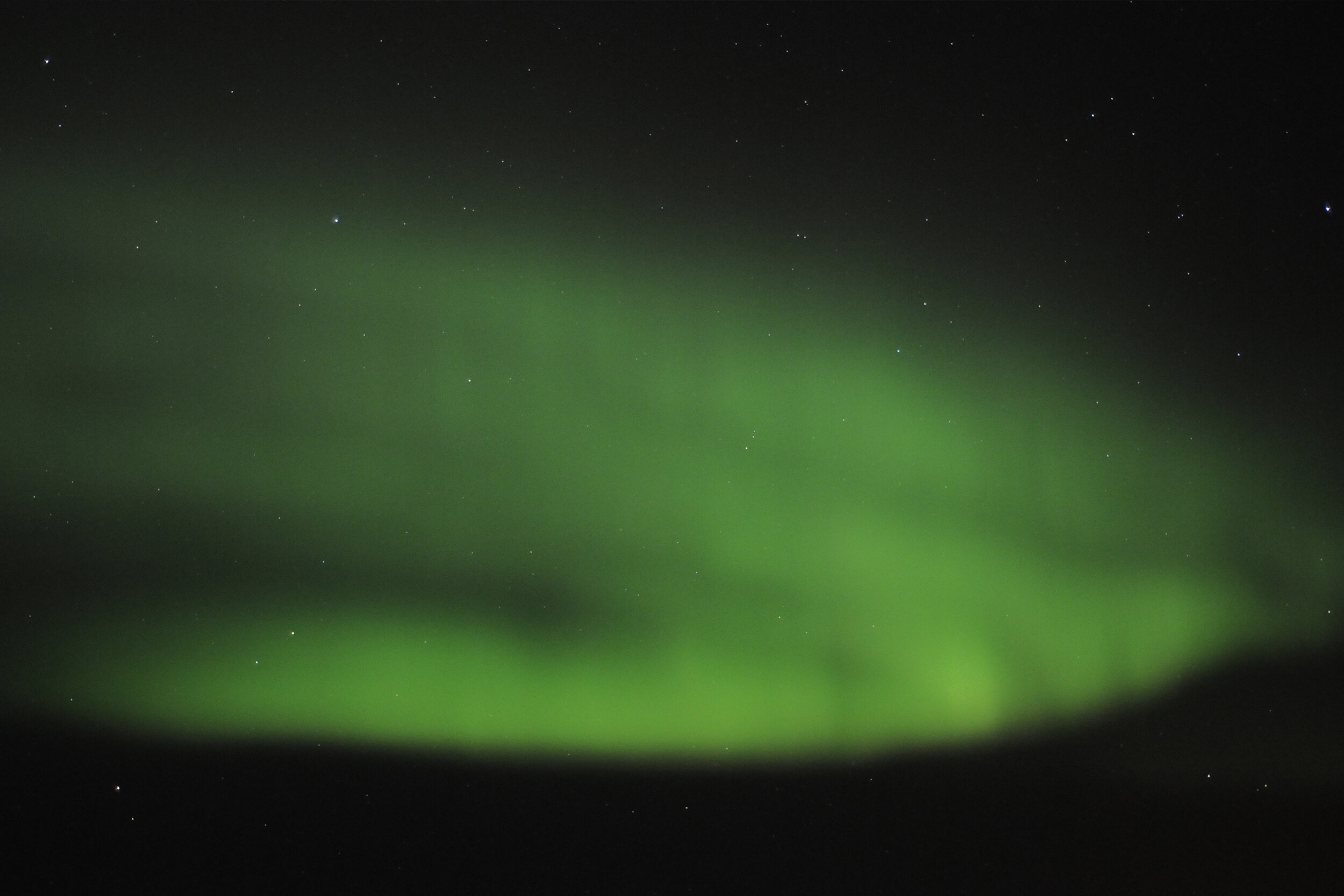
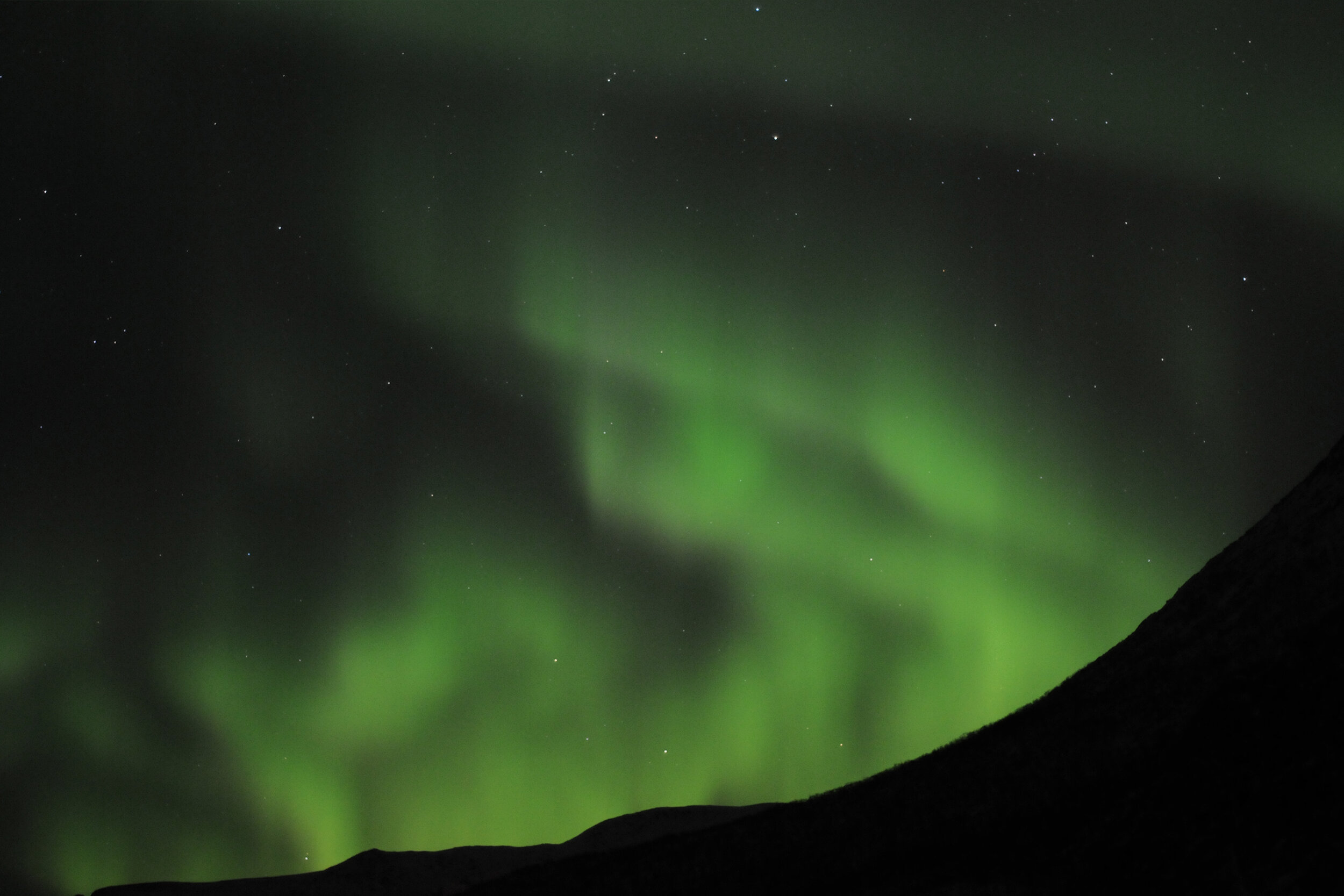
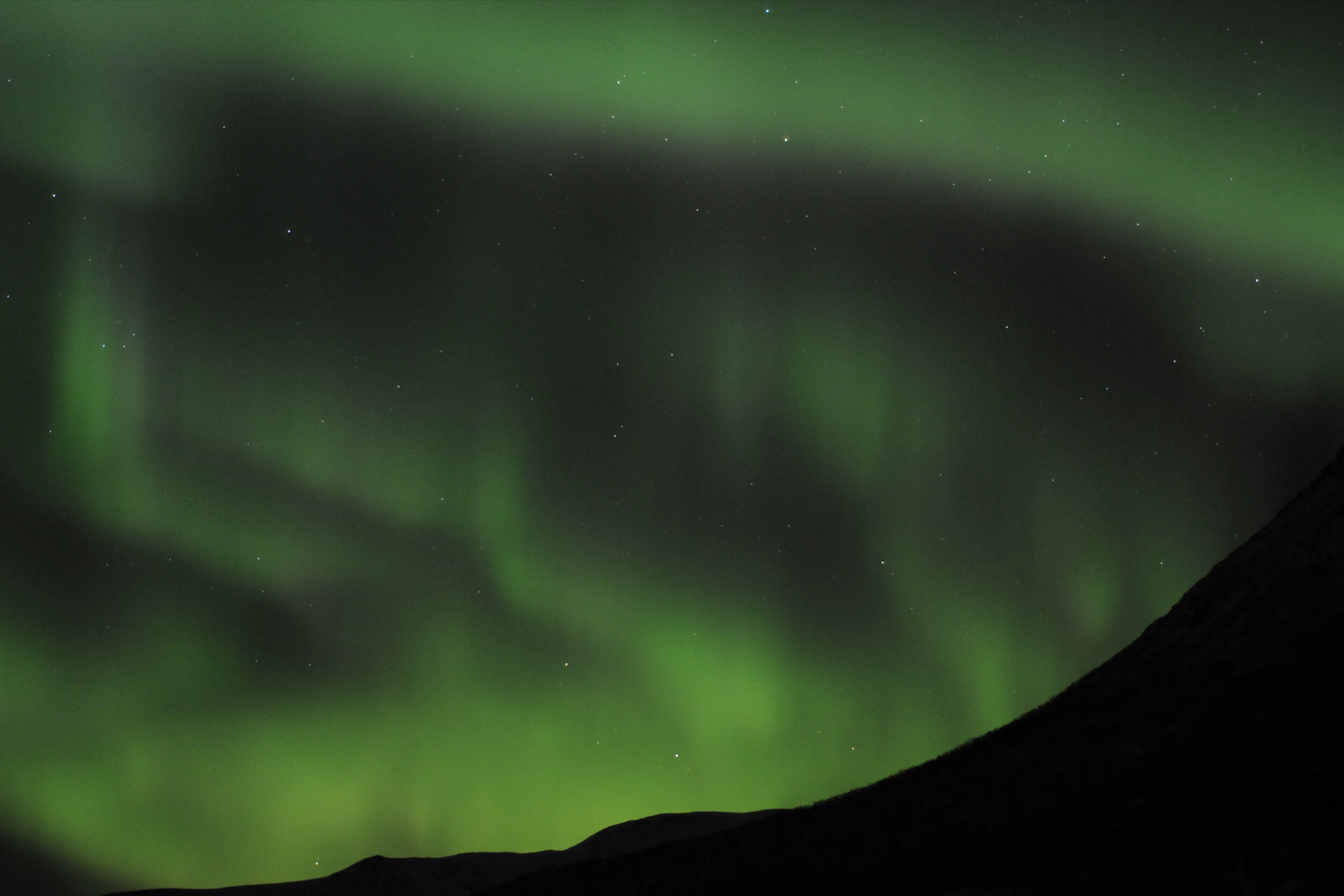
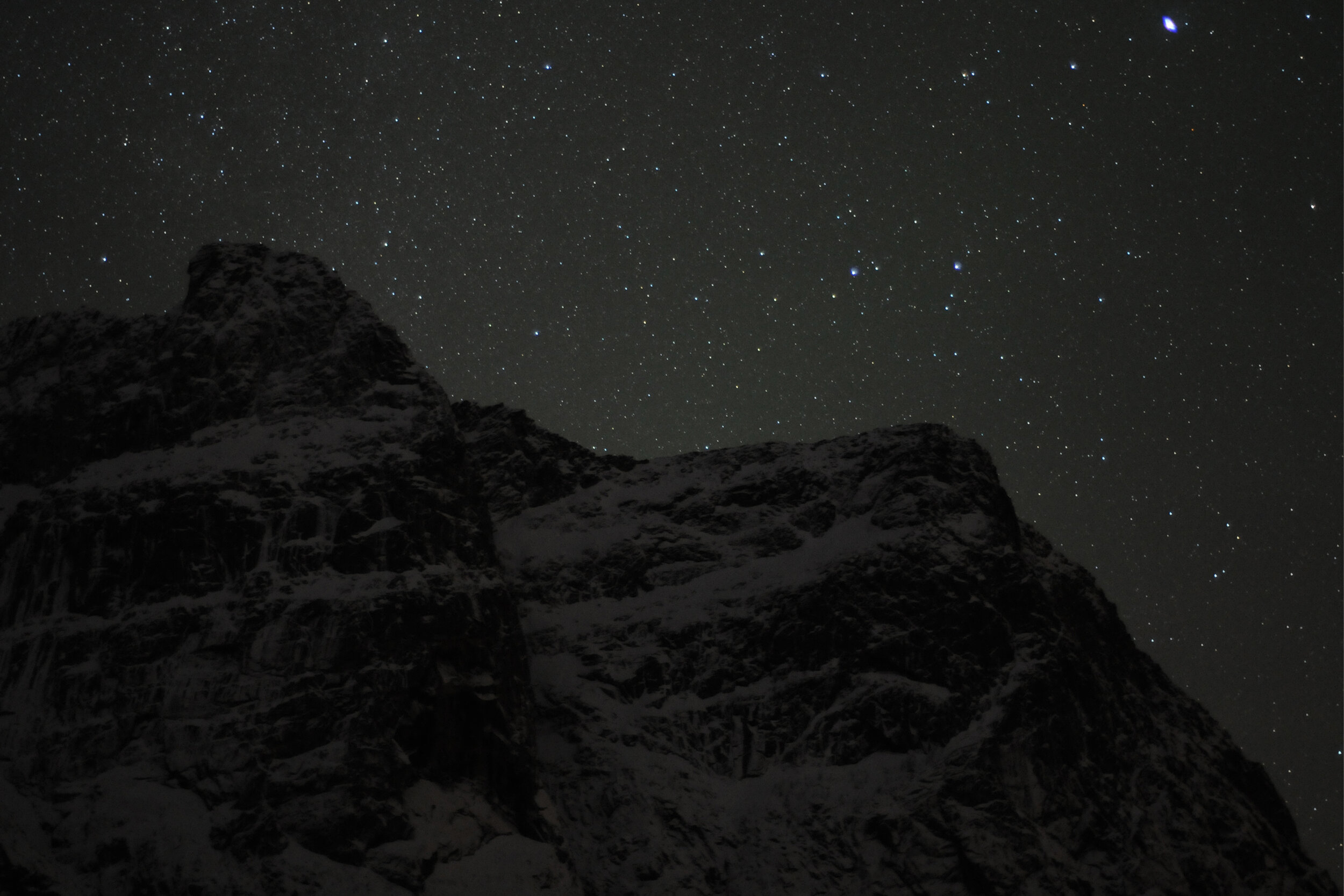
Northern Lights Safari
Though the Aurora can be seen above the city, the best way to see it is by traveling outside of Tromsø to escape from the light pollution. We managed to see the lights above the city one night during our stay but truly got to experience them during a “Northern Lights Safari” with a local guide. Local guides will take you outside the city to a nearby Fjord or as far away as Finland and Sweden to give you the best chance possible of seeing the lights. There are dozens of experienced guides and tour companies offering safaris to chase the Aurora. We booked with a company called Enjoy the Arctic.
We chose them over other companies because they offered smaller tours with a maximum of 8 people. It made for a more intimate and personal night as we waited for the Aurora to appear. We drove an hour outside the city to a fjord called Grøtfjorden where we were able to watch the Aurora dance across the sky nearly the whole evening. We even spotted a few meteors. Our guide helped us take photos, built a fire to keep us warm and provided us with warm drinks and veggie dogs to eat.
Aurora Spotting Tips
It needs to be very dark. Let your eyes adjust.
Keep flashlights pointed down or used red lights.
It needs to be a clear evening, preferably no clouds or haze.
Use an app called Norway Lights to watch the Aurora forecast. It told us what our chances were of seeing the Aurora based on our location and the time of night:
The human eye has a difficult time taking in enough light at night to recognize the Aurora’s true colors like cameras do. With your naked eye, it will appear mostly pale green or dark purple with the occasional flair of neon. Regardless of the intensity of its color, the Aurora is truly a sight to be see.
Any DSLR camera will be able to photograph the Aurora. Our DSLR settings were:
Camera (Nikon D300S)
50mm Lens
Aperture (F1.8)
ISO (1250)
Sutter Speed (2.5)
If you don’t have a DSLR but have an iPhone, you can buy a photography app called Northern Lights. It adjusts your phone’s camera to better photograph the Aurora.
Alway use a tripod to take photos. Your hands will be too shaky to take a clear image.
Dress in warm layers! It is going to be very cold and windy.
Sami Culture & Reindeer
The Sami People are a semi-nomadic nation spread throughout Scandinavia with a tradition based in reindeer herding. For thousands of years, they have established a livelihood using the reindeer for meat, fur and transportation. While in Tromsø, we booked an experience with Tromsø Arctic Reindeer, operated by a tour company and family of Sami people to promote their culture, share their stories and offer close experiences with their herd of reindeer.
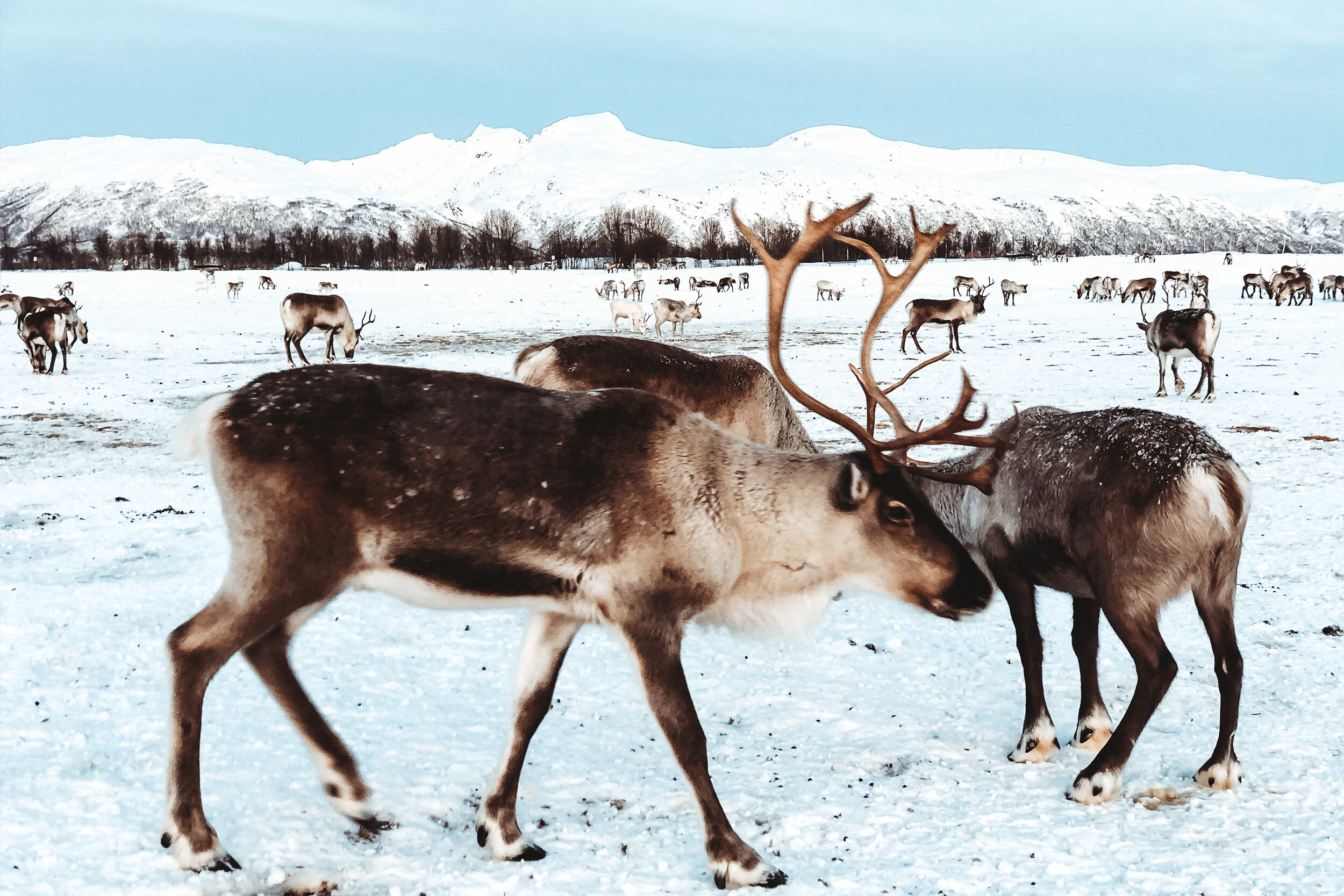
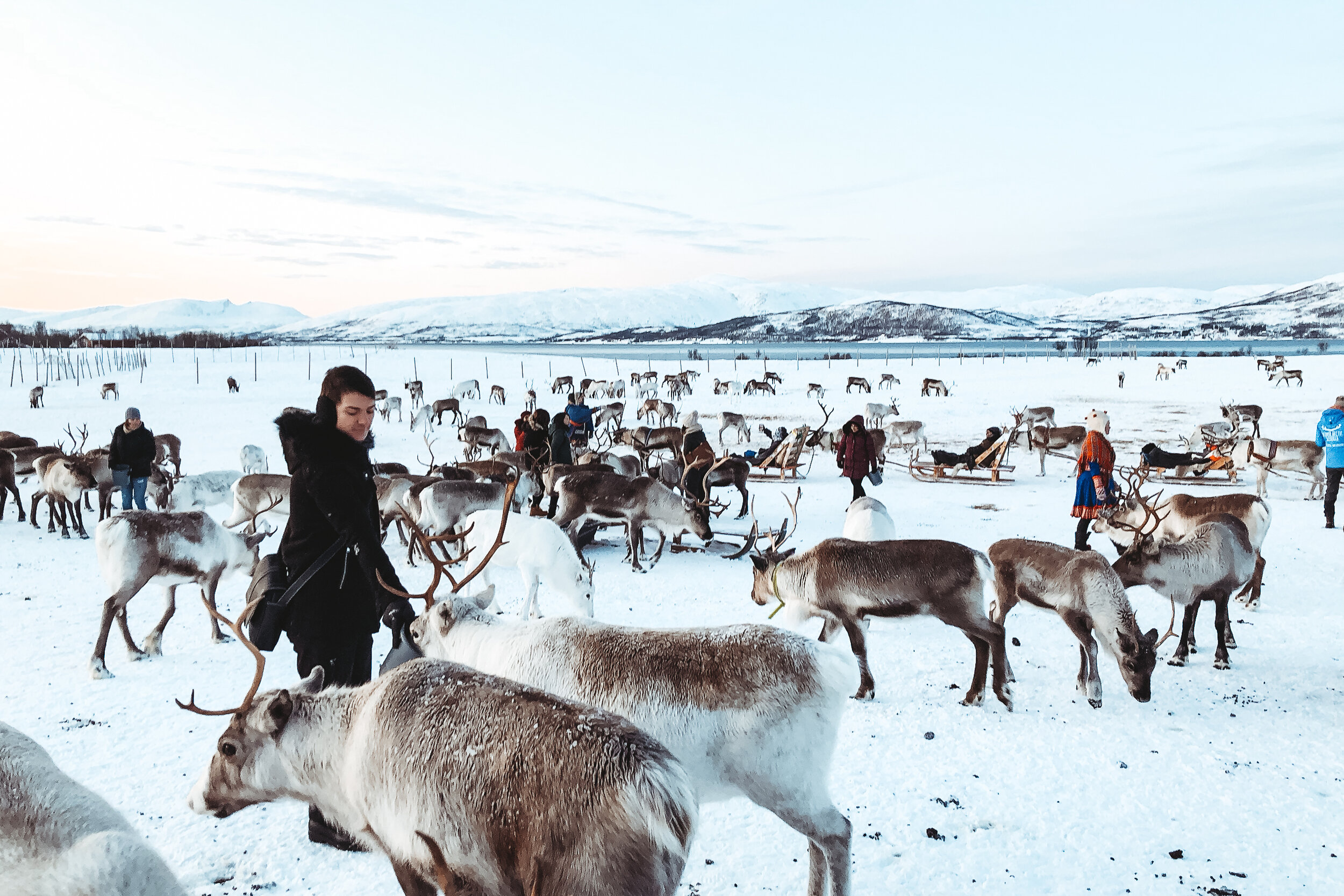
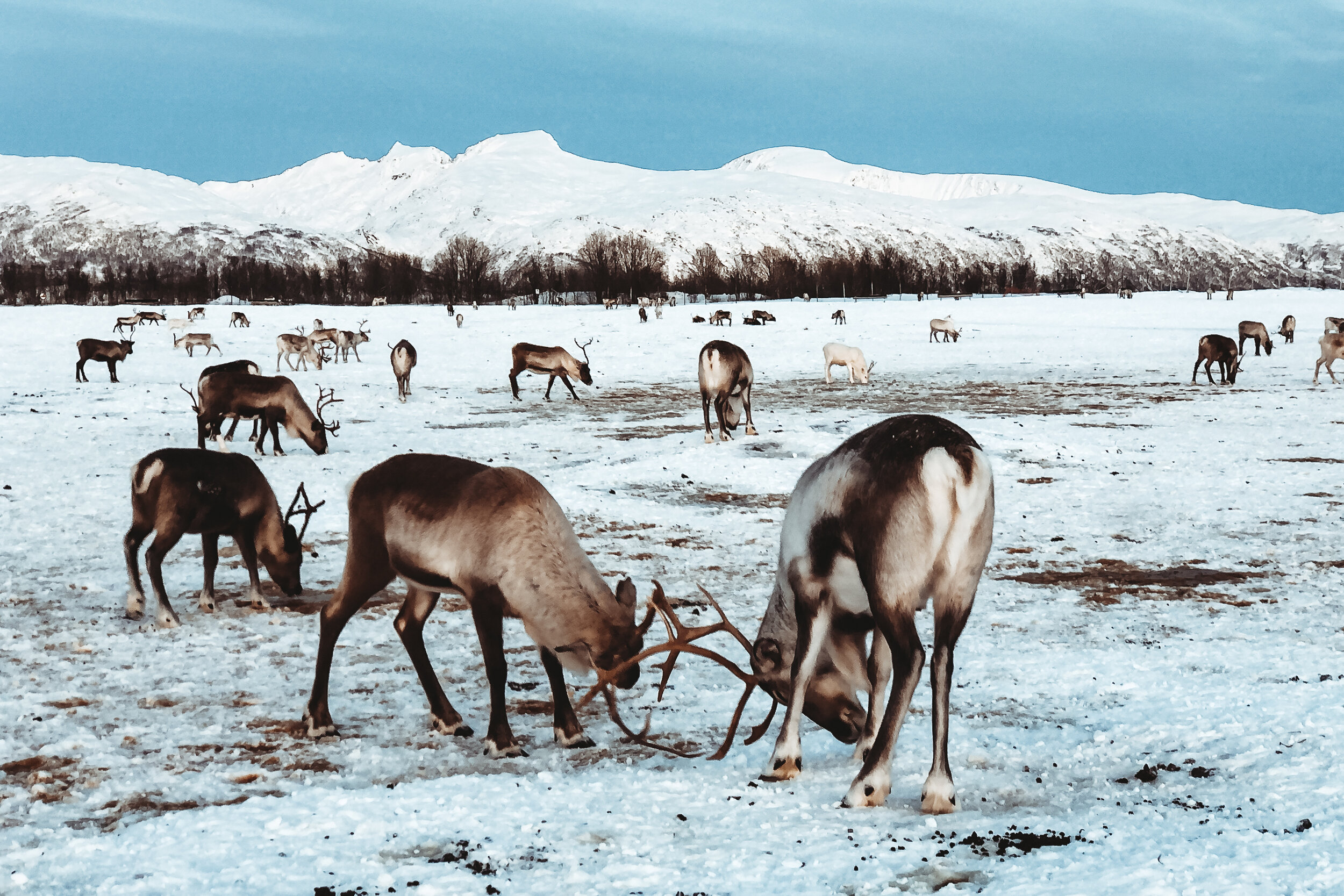
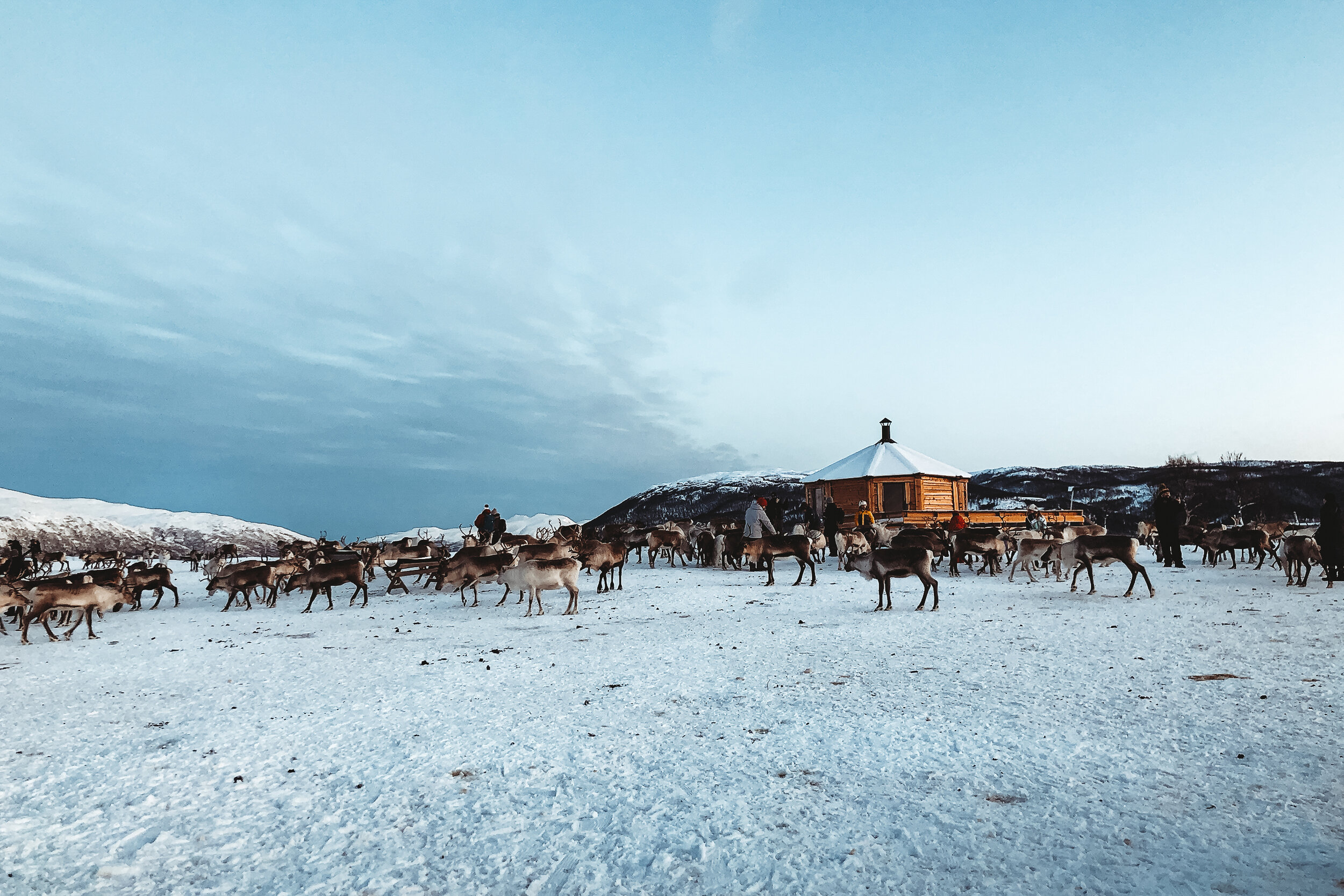

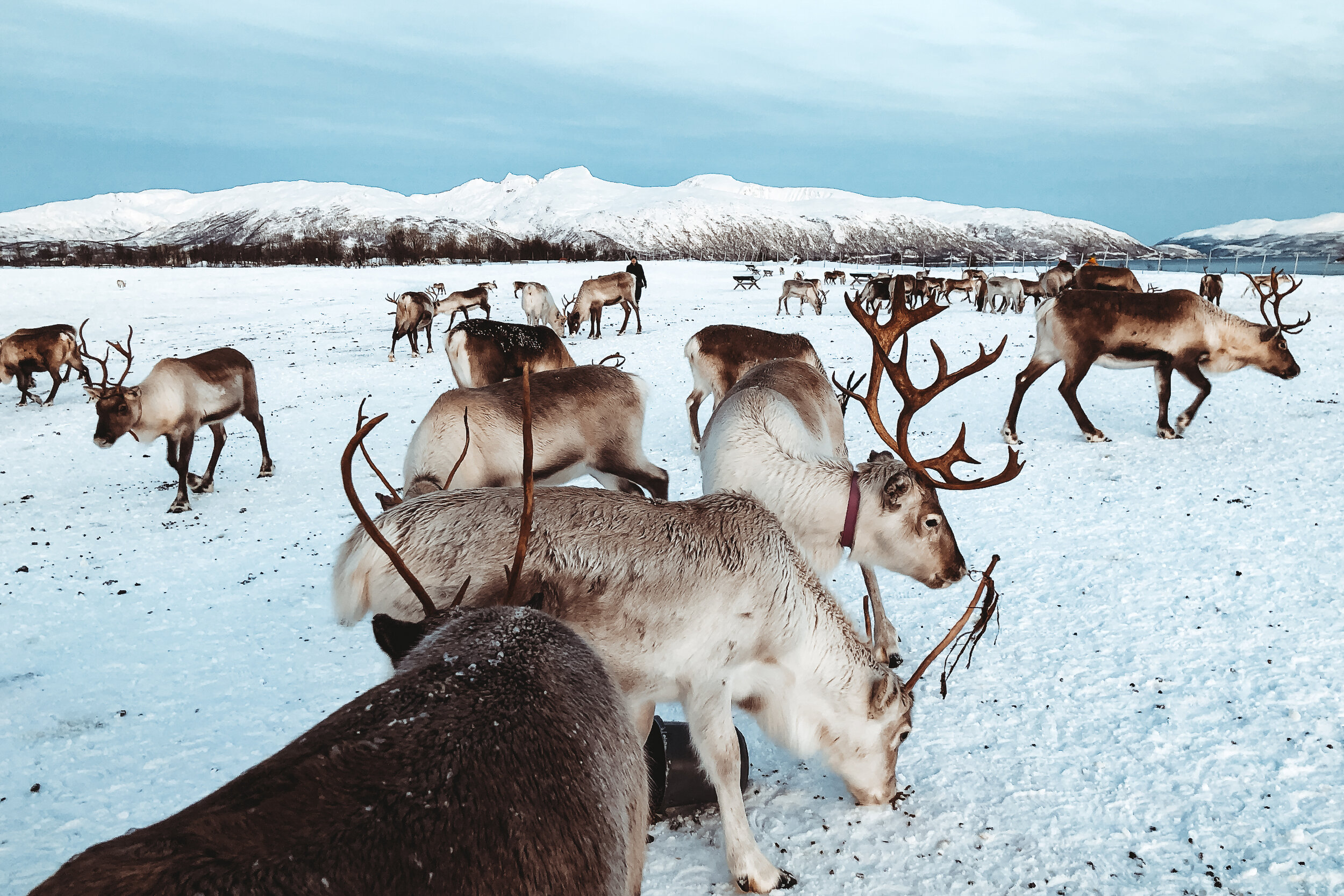
Sled Ride
To make it better, we then took a 30 minute sled ride. Guided by two Sami people, the reindeer slowly escorted us around their pasture. We were a little apprehensive about a sled ride at first but we quickly realized how well treated the animals were. They went at their own pace and didn’t seem tired or overworked in the slightest. The family genuinely showed care and love for the reindeer that they’ve herded for generations.
Reindeer Feeding
After our sled ride, we were able to feed them buckets of food (no, not the glitter and oats you toss outside for Santa’s reindeer) but hearty pellets of grain. They typically graze on the grass beneath the snow but once the snow is too packed down for them to break through they feed on pellets or relocate to a new field. The reindeer, still wild animals, were very excited for the food. They were gentle however at times one would nudge you for attention then burry their face into the bucket. It was amazing getting to be so up close and personal with these animals. Everyone, from children to their grandparents, had a memorable time interacting with the reindeer.
Sami Culture
After feeding them we went inside one of the tents where the family’s mother greeted us with hot coffee and cookies around a wood burning stove. We spent time here warming up before heading to a communal tent for dinner. Many people enjoyed the reindeer stew however we stuck to the vegetarian option. After dinner, we moved to a different tent, called a lavvu, known for communal gatherings and ceremonies. We sat around a log fire listening to the camp owner and multiple reindeer herders talk about their life and the Sami Culture.
They explained the purpose of the traditional clothing and items they carry, many of which were handmade from reindeer. They sung songs, called a joik, which is a traditional form of music sung to someone or something of importance in their lives. The eldest herder told us how he sings for the reindeer and to scare away predators. It was truly a one of a kind and educational experience getting to hear stories from the Sami people and feed their herd.
Snowshoeing & Fjord Tour
While in Tromsø, we wanted to take advantage of the incredible landscape and scenery of Northern Norway. The snow-covered mountain peaks and dramatic fjords were top of mind. We booked a snowshoeing excursion with another local guide company called Northern Horizon. They provided us with transport, an experienced guide, snowshoes, poles and a meal during our trip.
The Assent
Our guide took us and three others to a small town along the Norwegian Sea called Tromvik. The drive from Tromsø took a little over an hour and passed through, Grøtfjorden, the same fjord we watched the Northern Lights from. It was a beautifully scenic drive with remarkable fjord views.
From there, we drove further into the hillside before parking and ascending the mountain. We spent about 2 hours snow-shoeing the side of the mountain during the brightest hours of the morning before reaching one of its peaks. From the peak, we could look directly across the fjord at a salmon farm and straight out towards the Norwegian Sea.
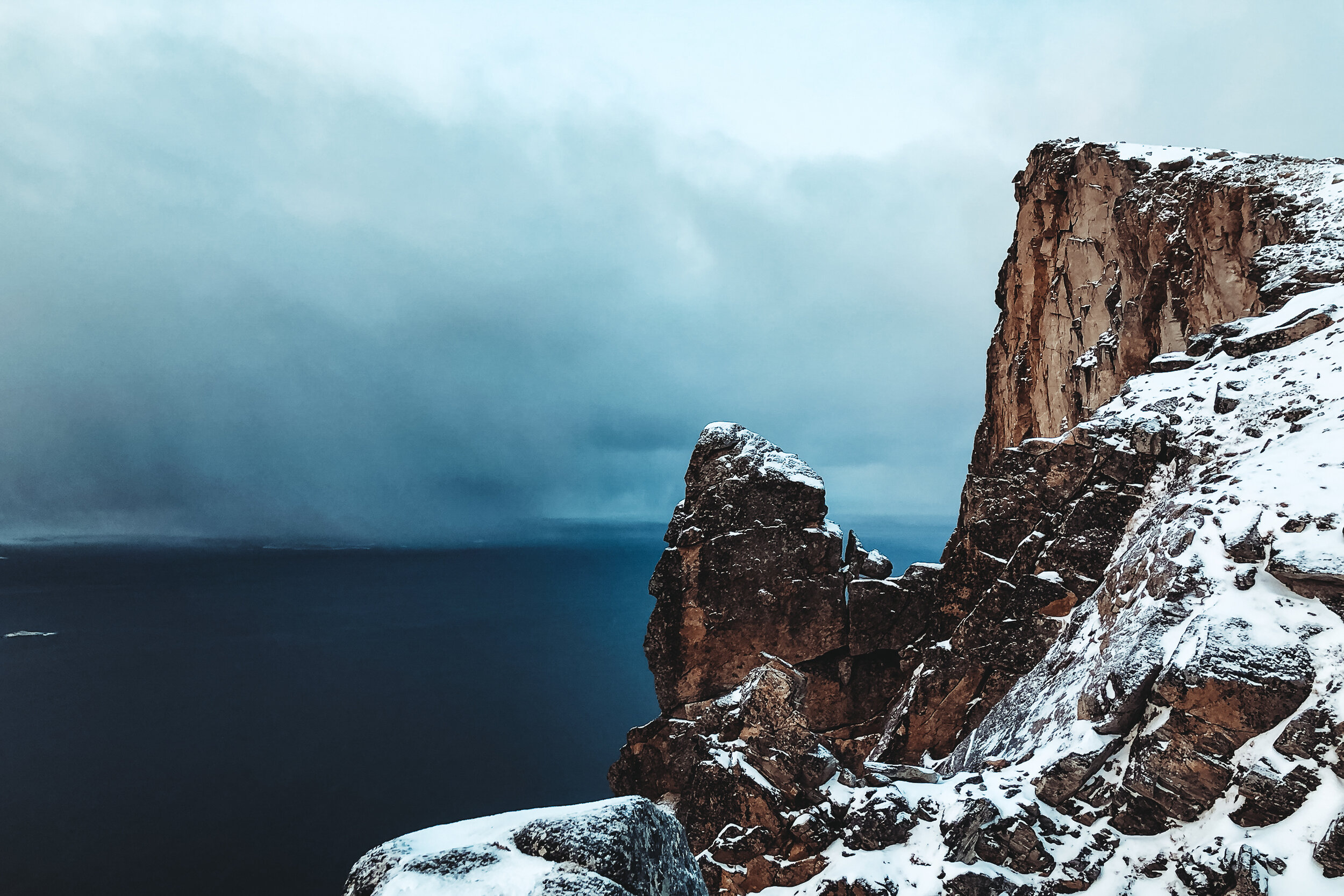
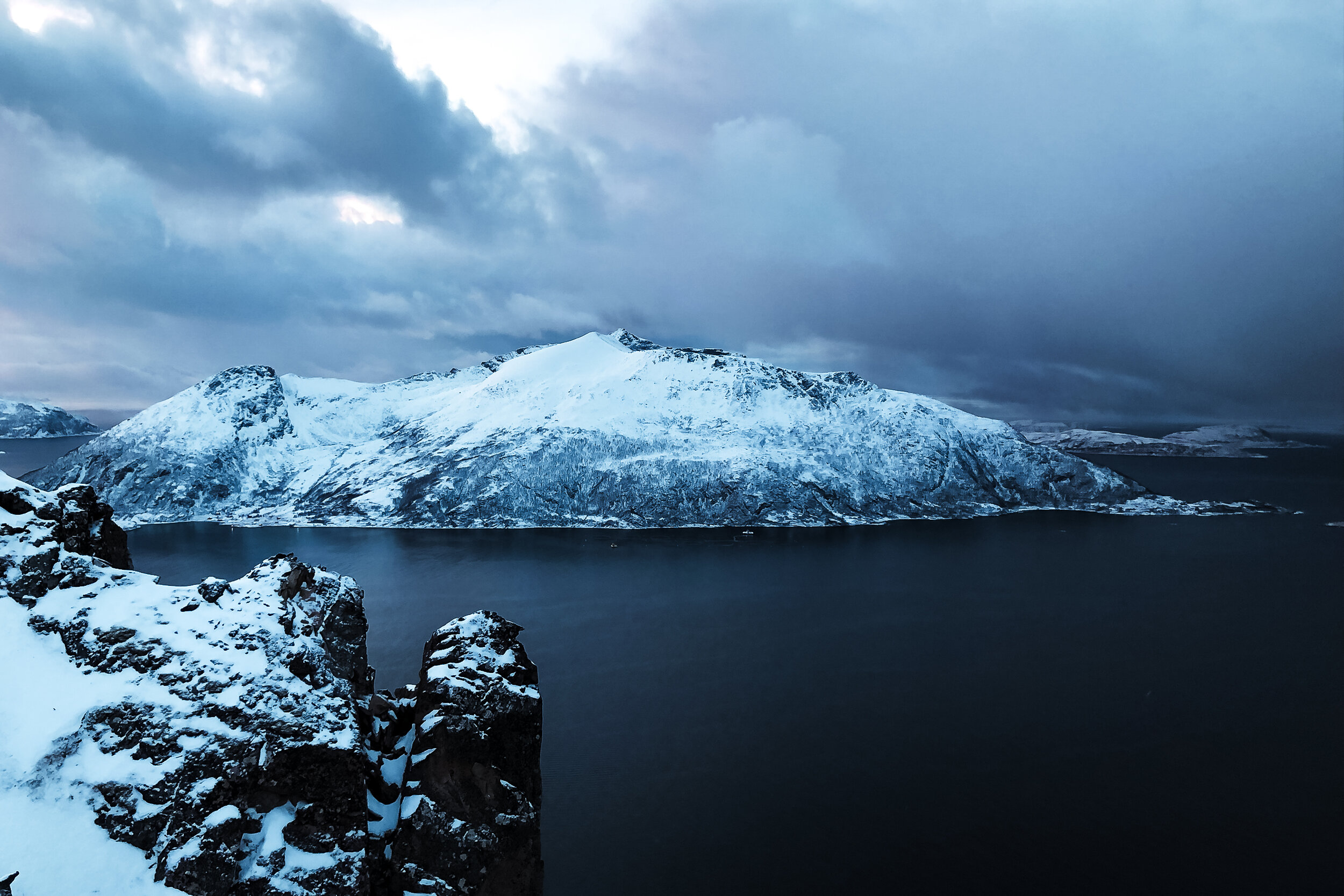
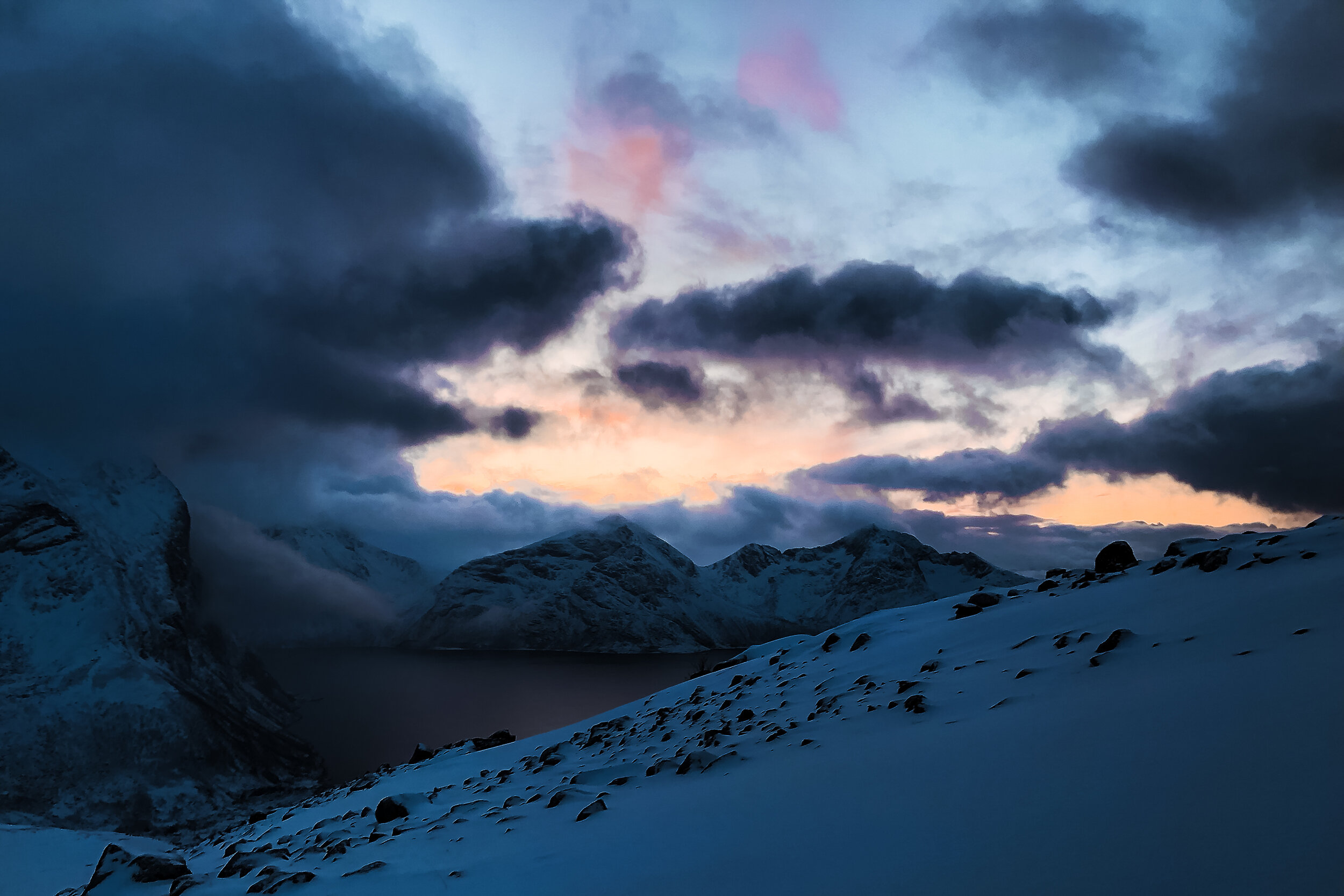

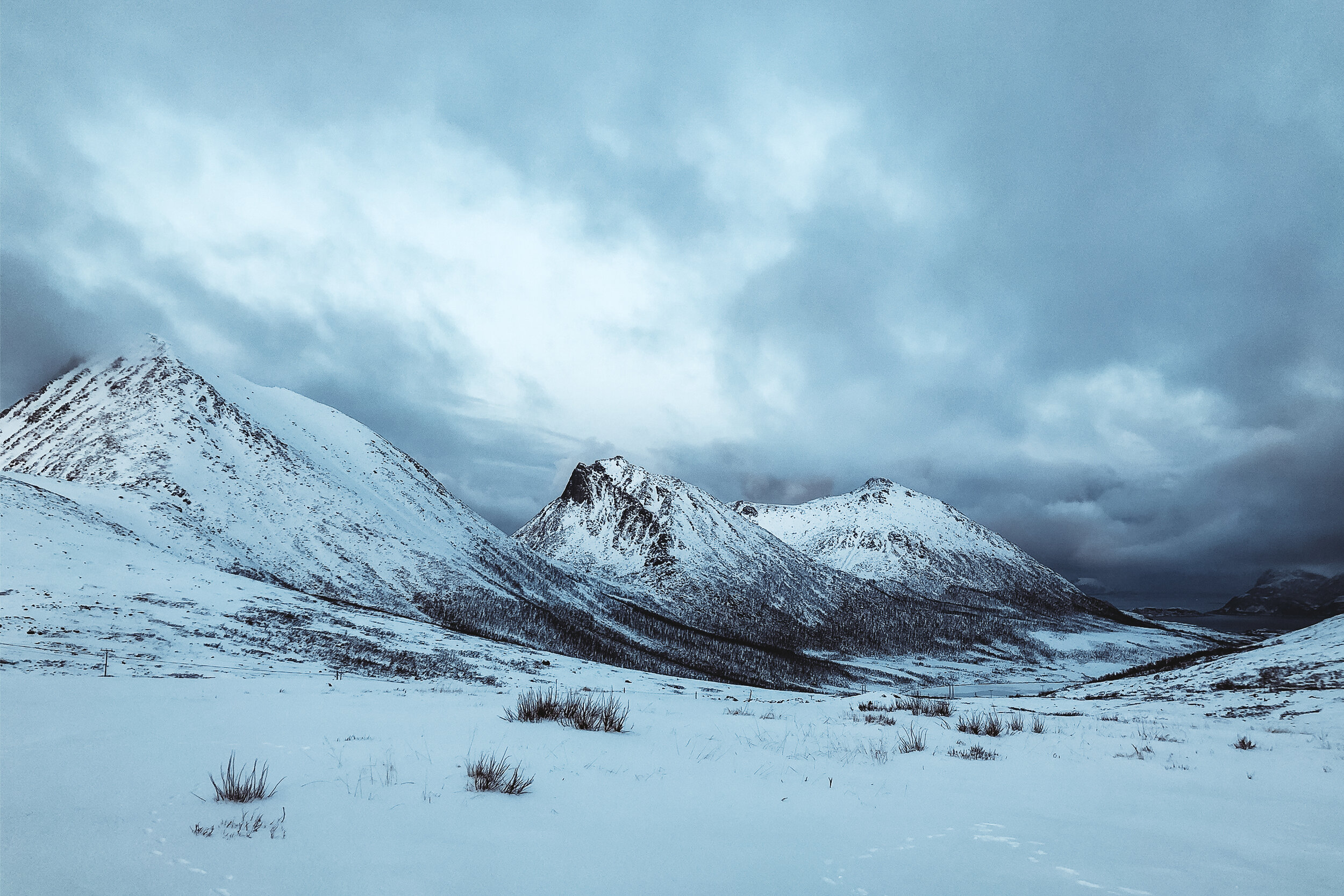
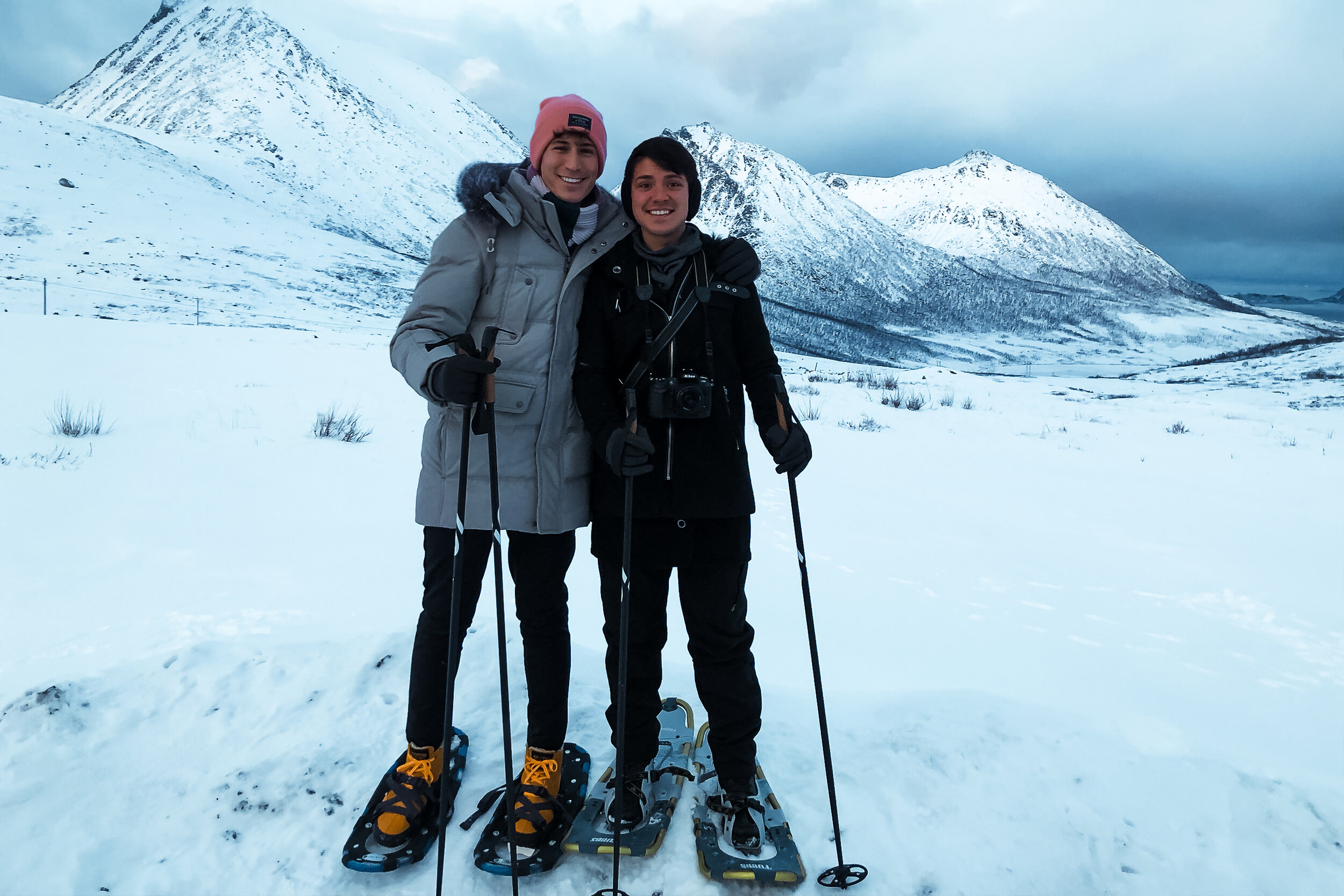
Prepare for the Weather
The hike wasn’t too difficult but it definitely helped having an experienced guide leading the way, watching out for icy crevices and incoming weather. The climate would change frequently. At times, the temperature would drop several degrees or a blizzard would roll in. This was especially true, the higher we climbed in elevation.
Norwegian Salmon
The decent down the mountain side took about 30 minutes. By the time we reached the car, it was nearly dark again. On our way back to Tromsø we stopped in a town called Kvaløysletta to visit Eide Handel AS, a grocery store with a deli counter displaying all types of Norwegian Salmon. They offered dozens of samples, which we tried, before buying a packaged smoked filet to bring home.
Sights & Museums
The Arctic Cathedral. Tromsø’s most recognized site is an Arctic architectural beauty. The modern cathedral, built in 1965, is inspired by the serene arctic landscape surrounding it. The 11 triangles that form its shape are reminiscent of snowy mountain peaks. The pews inside are made from local pine and cushioned in reindeer leather.
Tromsøbura. The 1km bridge connecting the island of Tromsøya, where most of Tromsø is located, to the adjacent island. The bridge has a pedestrian path which can be walked across in 15 minutes.
Fjellheisen (Tromsø Cable Car) Atop of the mountain across from the island of Tromsøya is an incredible lookout that offers views of the entire city and beyond. This is where we saw the Aurora on our first night. The view is accessible via a cable car or a series of 1,300 mountainside stairs. We took the cable car, however if you opt for the stairs and its snowy, make sure to wear spikes on your boots to prevent slipping and falling.
Storgata. The downtown Main Street lined with many restaurants, hotels, bars, cafes and shops.
Waterfront Warft. The city center and harbor surrounded by many contemporary buildings.
Skansen. A historic neighborhood located near Tromsøbura on Tromsøya with old painted wooden buildings from the 1850s.
Polaria. A poler aquarium designed to evoke the fractured ice floes seen throughout the Arctic waterways. Each shard of the building is stacked up against one another forming a giantess slanted mass.
The Science Center of Northern Norway. A planetarium with footage of the Aurora captured during a two year period. If we hadn’t seen the Northern Lights, this would have been the best alternative.
Lake Prestvannet. Fairly central on the island, the lake is surrounded by a number of hiking and cross country skiing trails.
Our Favorite Restaurants, Cafes & Bars
Fiskekompaniet. A higher end restaurant specializing in Norwegian seafood, this is where we had one of the best meals during our trip. We started with a creamy fish soup. It was served in a bowl with a delicate pile of smoked salmon and white fish. The server then poured a kettle of creamy broth over the fish filling the bowl. I enjoyed a crusted filet of cod with a side of potatoes and dill. Devin went for a Norwegian staple, Lutefisk. For desert, we shared a plate of cocoa and coffee ice cream.
Dragoy. Located along the waterfront warft. Dragoy is a deli counter that sells and cooks up fresh seafood. We shared cold water prawns with artesian mayonnaise on a large slice of sourdough bread. They’re also known for their fish and chips.
Bardus Bistro. Located inside an old yellow wooden house, this charming restaurant offers a small menu of traditional Norwegian dishes.
Bardus Bar. Located next door to Bardus Bistro, this bar offers the best cocktails in town. It’s great spot to stop before or after dinner next door.
Olhallen. This is the city’s oldest pub and brewery with a selection of nearly 50 different selections of beer.
Raketten. A historic outdoor kiosk offering hot chocolate, mulled wine, reindeer and veggie sausage. Next to the kiosk is a patio with seating and a warm log fire.
Smørtorget. A cafe offering pastries and open face sandwiches. It’s a great spot to have breakfast before setting out on an excursion.
FRØ. An inventive cafe, they make healthy sandwiches from thin waffles and also known for their pistachio cream buns.
Norwegian Food & Drink
Lutefisk. Air-dried white fish that goes through a several day process involving soaking in water and lye to rehydrate the fish. As the fish rehydrates, it looses a portion of its protein becoming slightly gelatinous. The fish is then cooked and served with potatoes and multiple condiments and sides including peas, pickled veggies, brown cheese, melted butter and mustard.
Norwegian Salmon. Caught and farmed in the fjords of Norway, Salmon is prepared and served in many ways. The most common styled is smoked though it is also often fried, boiled or served raw.
Pickled Veggies. Almost every meal we enjoyed was topped with pickled veggies. Carrot, fennel, beed, cucumber and onion were quite common. They added extra flavor and color to each dish.
Lefse. Traditional Norwegian flatbread made with potatoes, flour, butter, and milk.
Buns. A pastry that ranges from sweet rolls, to swirls or knots.
Mulled Wine. Hot spiced wine was very popular. The Norwegian way of making it is by adding a spoon full of chopped nuts and raisins before serving.
Getting Around
Getting to Tromsø. To fly into Tromsø, you’ll likely need to transfer in Oslo. Booking directly through Norwegian Airlines is usually the most convenient and affordable option. Tromsø is about a 2 hour flight from Oslo.
To/From Tromsø Airport. Use Flybussen, the airport express bus. It routinely travels in a loop from the airport to multiple hotels in central Tromsø. It costs roughly $18 for a round trip ticket.
Getting Around Tromsø. The city and surrounding area is walkable, though a bit hilly and icy during the winter. The main street, Storgata, has heated sidewalks that keep snow and ice from freezing. Outside of this, it’s best to be cautious while walking on the snow and ice. We had a few slips ourselves but were layered in enough clothing to keep us from bruising. We noticed that many people wore spikes on their boots for extra traction. Just remember to take them off before entering indoors. One of the cutest things we saw were mother’s pushing their children in strollers with sleds instead of wheels.
Taxi. Taxi’s can be pricy but are convenient when trying to get around outside the Main Street. The two main taxi companies are Tromsø Taxi and Din Taxi. Uber is not yet an option here. This is a general breakdown of cost:
Around Town: $10 - $15 (From downtown to the cable car)
Across Town: $16 - $35 (From the airport to downtown)
Outside of Town: $36 - $60 (From Tromsø to a nearby town)
Getting Outside of Town. Renting a car is the best option to get between Tromsø and anywhere else outside the city. Nearly all excursions will include transportation to and from.
What to Wear
If you’re visiting in the wintertime like we did, you need to dress warm. It is the Arctic after all. You’ll need a base layer, mid layer and outer layer. Tuck your base and mid layers into each other to better hold in heat and prevent wind from getting under your clothes. In addition to layers, we also used thermal toe and hand warmers while we were snowshoeing and watching for the Northern Lights.
Base Layer
Thermal underwear
Thermal long sleeve shirt
Wool socks
Wool gloves
Mid Layer
Jeans or pants
A cute Norwegian sweater (you can buy one in town)
A lightweight quilted jacket (down or down alternative)
More socks (you’ll need to double up)
Outer Layer
Snow pants (mainly for extended periods outdoors)
Winter coat (you’ll want something that will break the wind and truly keep you warm)
More gloves (you’ll need to double up)
A warm scarf and hat
Boots (bring strap on spikes or cleats)
If we had more time…
Vulkana Spa Boat. This boat has a saltwater hot tub, sauna, steam bath and zen lounge with a fireplace. The crew also provides dinner and facilitates cold water plunges in the harbor.
Husky Experience. The are various companies that multiple types of Husky experiences. Some experiences include husky mushing, dog sledding and even cuddling with the cute puppies. Experiences can vary from short 30 minute trips, to hour long excursions and overnight stays watching for the Northern Lights.
company we looking into is Aurora Husky Trekking
Whale Spotting / Fjord Tour. Orcas and Humpbacks are frequently seen in the winter months from November - February while hunting for herring. There is a number tour companies offering boat trips through the fjords and sometimes into the Norwegian Sea. Two of the companies we looked into are Wild Seas and Pukka Travels Rib Boats.
Wild Seas specialized in protecting, researching and observing the whales. They’re an ethical company that will take you on a full day tour using special equipment to listen for whales and observe from a healthy distance.
Pukka Travels offers multiple fjord tours where you can go sightseeing, whale watching and arctic fishing.













